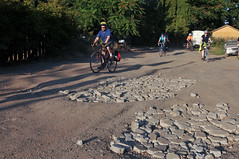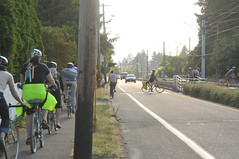
the report at a meeting last night.
(Photos © J. Maus)
The Portland Bureau of Transportation has released the public draft of their East Portland in Motion report, a five year strategy that sets a blueprint for improving biking and walking conditions in East Portland.
Work on the report has taken place over the past year through a variety of public meetings and surveys. The purpose, says a Bureau of Transportation (PBOT) statement, is to, “create a seamless network of accessible trails, sidewalks and bikeways that enable active transportation in the community.”
“I’m quite proud of the fact that we did a much different kind of process than PBOT normally does… to get a broad variety of inputs.”
— Ellen Vanderslice, PBOT
Far from just another plan with a wish list of projects that will never see the light of day, East Portland in Motion is an “implementation strategy.” It has funding behind it and the political urgency to get the projects on the ground immediately.
Last night at the PBOT Bicycle Advisory Committee meeting in City Hall, project manager Ellen Vanderslice shared the report. “We tried to take the known universe of projects already out there,” she explained, “and figure out what we can accomplish over the next five years, both with funding we already have and funding we expect to get.”
The backstory here is that East Portland residents have long accused City Hall of neglecting their needs. While the Central City gets all the attention and investment, residents complain, areas east of I-205 get very little (there’s a must-read in-depth story about this in the current edition of the Willamette Week).
But in recent years, PBOT has stepped up its efforts. The East Portland in Motion report is a testament to the renewed focus on the area. It also reflects lessons PBOT has learned in approaching communities who are skeptical of their intentions.
After getting burned by the SE Holgate buffered bike lane project, PBOT made sure to be very attuned to community perceptions this time around. Vanderslice told us last night that part of the East Portland in Motion process was to survey the community to learn more about their perspective on active transportation — before proposing any list of projects.
In their press release last week, PBOT wrote that they’ve come up with a set of projects that are not only feasible from an engineering and funding standpoint, but “are supported by the community” as well.
Taking a cue from the Community Cycling Center, PBOT enlisted experts from Portland State University to host group interviews with people who aren’t usually a part of the public process. “I’m quite proud of the fact that we did a much different kind of process than PBOT normally does… We heard from voice we don’t usually hear from… We spoke to Somalis, Ukrainian immigrants, and others, to get a broad variety of inputs,” said Vanderslice.
Vanderslice says those conversations yielded important feedback. “We learned lots of people don’t see bikes in their future.” In addition, Vanderslice says they also heard major support for access to transit and safe routes for kids to walk and bike to school. And, “no matter what their attitude was about biking,” she added, “they supported neighborhood greenways” (PBOT’s name for bike boulevards).
It makes sense to approach East Portland differently, because in many respects it’s like an entirely different city. The population in East Portland has a higher percentage of people living in poverty, it is more ethnically diverse, and it has been developed in a completely different way that other areas of Portland.
Vanderslice explained last night that the area grew quickly while it was still unincorporated. Instead of the grid network of small streets that are a legacy of Portland’s old “streetcar neighborhoods,” a lack of land-use planning east of I-205 has led to a landscape where major arterial streets dominate. Because of that, Vanderslice “It’s very difficult to find connections… It’s been an interesting challenge.”
Without connections or safe crossings, many people navigate around high-speed, high-volume arterial streets any way they can — often with tragic results. Projects identified in this report could vastly improve safety.
In total, the draft report calls for 20 sidewalk infill projects (there are many sidewalk gaps on major arterials), 56 crossing improvements on busy streets (56!), 10 neighborhood greenways, bike parking, and even a few bits of shared-use path. The major bike-centric projects include a north/south neighborhood greenway along the 130s and east/west greenways on Market, Mill, and Main Streets.

The big focus on neighborhood greenways is a key to East Portland’s active transportation future. They’re, “a scaffold,” says Vanderslice, “onto which the full buildout of future bikeways will occur.”
And here’s the good news. “All the lines on this map,” said Vanderslice, holding a map showing all the proposed projects, “should be doable in five years.”
Money for the plan comes from a mix of state gas tax revenue, federal grants, and PBOT’s traffic safety fund. When I asked Vanderslice for the total amount for all the projects, she said they aren’t giving out a lump sum number. The reason? After the PR debacle created by repeated misrepresentation of the “$600 million bike plan” by the media, that’s just another one of the lessons they’ve learned.
—
East Portland in Motion is in a public comment period until October 31st. Want to learn more? Take a bike tour of East Portland with some of the city’s transportation bigwigs, come to PBOT’s next Brown Bag discussion or check out the official project page.









Thanks for reading.
BikePortland has served this community with independent community journalism since 2005. We rely on subscriptions from readers like you to survive. Your financial support is vital in keeping this valuable resource alive and well.
Please subscribe today to strengthen and expand our work.
Some good news in the world for once. 🙂
even better, it’s good news east of 82nd!
Are some of these projects going to get lost in future process? I really hope these improvements actually move forward. I guess I’ll believe it when I see it. For once, something may be getting done!
I was hoping the Bush St. Bike Boulevard was going to get finished this summer, but after installing the last of the speed bumps just after school let out, nothing. Summer came and went with no work done at all. Let’s get that signal installed at 122nd already!
If this meeting had actually taken place IN East Portland, I might have attended…
For those who want to be involved with biking in East Portland, there’s also an East Portland Action Plan Bicycling Sub-Committee that meets monthly (third Thursday of each month, 6:30 p.m. at Muchas Gracias in Gateway) for advocacy and event-planning: http://epapbike.org
The EPAP bike meeting is a great way to get involved in east Portland biking. I know the East Portland in Motion team has met with them regularly throughout this planning process, and I presume they’ll be presenting the final plan to them if they haven’t already.
That 130s project is SO NEEDED. Thanks PBOT! I’m looking forward to using it as soon as it is completed.
Even though I live in very inner SE and would hardly ever use the facilities in question, I made my comments in favor of the 130s project. East Portland has long been neglected, and this is at least a start towards righting the wrong.
(For the record, I also entered comments in favor of the Springwater-to-Trolley connection, and in opposition to a publicly funded for-profit Bikesharing project when there are so many other worthy projects out there).
In response to one point made in this article, you can calculate a poor-but-better-than-nothing estimate of the total cost if you just add up all the estimates they attributed to each project in the published East Portland in Motion document–though Vanderslice makes a good point about the psychology of those numbers. I think folks expect the cost of an infrastructure project to only cover raw materials.
“While the Central City gets all the attention and investment, residents complain, areas east of I-205 get very little.”
While I generally like what I see on bikeportland, I’m worried that many of the outer east-side neighborhoods getting lost in this “east-of-205” mentality. We live in NE, between 82nd and 205 on an unpaved road, in a relatively poor and under-served neighborhood. We, too, are part of outer east Portland and live in one of the neighborhoods that I’m happy to say will be served by this project.
I agree the downtown and close-in neighborhoods seem to get an inordinate amount of money put toward their infrastructure, art, development projects, etc. etc. But please consider that I-205 is not an all-important dividing line between the haves and the have-nots. There are many, many have-not neighborhoods that are not east of the interstate, as I can attest.
I think more inclusive language to this effect would be a step toward making sure that everybody’s voice is heard (and needs met).